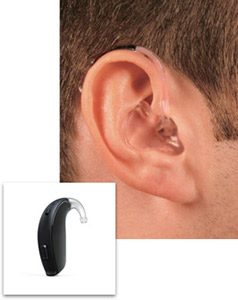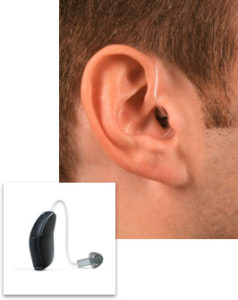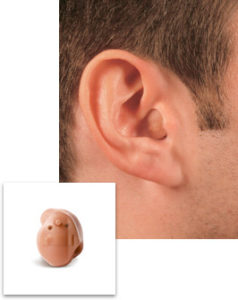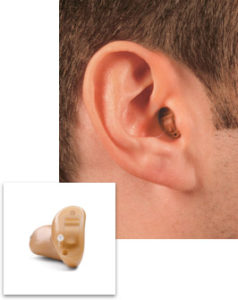
There are several types of hearing aids available today, each designed to address specific hearing needs and preferences.
It’s important to note that, depending on your individual style and level of hearing assistance required from your aid, the type/shape of the aid needed may vary.
Having a hearing aid that suits your needs and fits comfortably in the ear is the most important part of a healthy relationship between you and your hearing aid. There should be no compromise between comfort and sound quality.
Whatever style you choose, a good fit in the ear is essential because it allows sound to be channelled into the ear without letting any amplified sound leak out which leads to feedback (whistling).
Here are some common types:

Behind-the-Ear (BTE)
A BTE hearing aid is curved to match the contour of the ear and rests directly behind the ear. A tube connects the hearing aid portion to an earmold, which is custom fit to your ear canal. This type of hearing aid is appropriate for people of all ages and is powerful enough for all types of hearing loss.
A BTE hearing aid:
Traditionally has been the largest type of hearing aid, though some newer mini designs are streamlined and less visible
Is capable of more amplification than other styles
May be more bulky
Now available with a rechargeable battery

Receiver-in-the-Canal (RIC)
A RIC hearing aid is a variation of the behind-the-ear hearing aid. A thin wire, rather than tubing, connects the piece that sits behind the ear and in the ear. This style keeps the ear canal open, allowing low-frequency sounds to enter the ear naturally and high-frequency sounds to be amplified through the hearing aid. It’s a small and discreet style of hearing aid but powerful enough for treating mild to moderately-severe hearing loss.
The receiver-in-the-canal hearing aid:
Has a less visible behind-the-ear portion, is very discreet
Offers a more natural sound quality of your own voice
May be easier to carry
Now available with a rechargeable battery

In-the-Ear (ITE)
This hearing aid style is designed to fill the outer portion of the ear and is larger than those worn in the ear canals. It is less discreet, but the size allows for more features, larger batteries and makes the unit easier to insert and remove. Those with mild to severe hearing loss can benefit from this style.
An in-the-ear hearing aid:
May include features such as volume control and directional microphones that are easier to adjust
Is generally easier to insert and remove
Uses larger batteries, which are easier to handle and last longer
May be susceptible to earwax clogging, so wax guards need to be changed every few months
May pick up more wind noise than smaller devices
Is more visible in the ear than smaller devices

In-the-Canal (ITC)
The ITC hearing aid style is designed to fit partly in the ear canal, but not as deeply as a CIC device, resting securely in the lower portion instead. Due to it being slightly larger than a CIC hearing aid, it is easier to insert and remove and its battery life is longer. This style is best for patients with mild to moderately-severe hearing loss.
An in-the-canal hearing aid:
Is less visible in the ear than the larger ITE style
Offers larger batteries than the CIC style
May be susceptible to earwax clogging, so wax guards need to be changed every few months

Completely-in-the-Canal (CIC)
A CIC hearing aid is molded to fit deep inside your ear canal and is the smallest style available. It takes advantage of the ear’s natural ability to collect sound and it’s small discreet size makes the device virtually invisible to others. This style may be a good choice for mild to moderately-severe hearing loss.
A completely-in-the-canal hearing aid:
Is the smallest and least visible type of hearing aid
Uses very small batteries, which must be changed frequently
Doesn’t contain extra features, such as volume control or directional microphones
Is more difficult to manage for people with dexterity issues
May be more susceptible to earwax clogging, so wax guards need to be changed every few months

Open-Fit
The open-fit hearing aid is a smaller version of the BTE hearing aid. Like the BTE style, it rests behind the ear and uses a thin transparent tube to deliver sound to the ear canal through a small earpiece. This style keeps the ear canal open, allowing low-frequency sounds to enter the ear naturally and high-frequency sounds to be amplified through the hearing aid. It’s a small and discreet style of hearing aid but powerful enough for treating mild to moderately-severe hearing loss.
The open fit hearing aid:
Has a less visible behind-the-ear portion
Offers a more natural sound quality of your own voice
May be difficult to handle due to small parts and batteries
Now available with a rechargeable battery